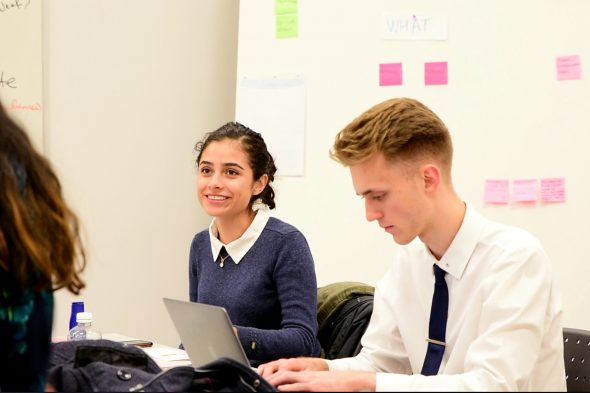East Meets West: Innovative solutions to health care problems

Students in the Interdisciplinary Product Development class work together to help poor, rural and elderly patients stay connected to health care services. (Photo: Fan Wang)
Teams in business wear gathered at the UIC Innovation Center, ready to brief experts and industry leaders — their clients — on projects they and their peers had put together after almost a year of learning, doing research and looking at problems from different perspectives.
But the presenters weren’t exactly working for a firm or company.
Instead, the groups were part of a course open to UIC students from different colleges, a year-long class that takes a page out of playbooks used by professional problem-solvers. It’s called Interdisciplinary Product Development.
“Students are learning how to innovate,” said Peter Pfanner, executive director of the UIC Innovation Center, where the class and its lab take place. “They work in interdisciplinary teams with students in design, engineering and business to address and come up with solutions to problems or a problem statement that comes from our partner.”
The longstanding course has had external sponsoring partners like the Fortune 100 corporation Caterpillar over its years of existence.
This year, OSF HealthCare, a 13-hospital health system operated by the Sisters of the Third Order of St. Francis, was the sponsoring partner. The organization implements technology in health care.
Besides being a perfect fit for the course, the partnership came with the perfect opportunity: to include public health students.
“The advantage is the public health students provide the technical expertise around the language of health care and the language of public health,” said William Kling, clinical assistant professor of health policy and administration in the School of Public Health. “They also understand how the systems work together for the patients and for the community.”
The project asked teams of students to think about how OSF could help poor, rural and elderly populations stay connected with their services, resources and activities. The point is to help patients mitigate isolation and its negative outcomes, including poor health and emotional distress.
“The class starts the first semester by understanding what the problem really is,” said Michael Scott, director of the Interdisciplinary Product Development Program. “Then, the students come up with a large number of possible solutions that could be used to address this problem. Those solutions are prototyped and tested, meaning we go back to the users and get their reactions.”
This method helps teams refine their solutions and stick with one prototype. At the end of the academic year, the partnering sponsor can take that prototype and develop it.
Caterpillar and Cobra have created products using prototypes from the class. Other sponsors like BMW have recruited students.
“Many students go on to work in this area,” Scott said. “Some of them each year get positions directly at organizations that have been sponsoring.”
The reason? Participating students leave with real-world design and development experience.
Sheccid Eloisa, an undergrad in business, took the class because she wants to pursue a career in product development after she graduates.
“Overall, it’s great working with the other concentrations,” she said. “As a marketing student, I tend to focus more on the analytics part, the data, money, the business aspects. Just having things tied together, your project goes in different ways than you would expect.”
Lorenzo Grego, a second-year master’s student in public health, agrees.
“One of the key pieces, which is imparted to us in our program, is the understanding that everything is a multisystem effort when it comes to effectuating actual change,” Grego said. “This class is really the closest you can get to that in an academic setting as a student.”
